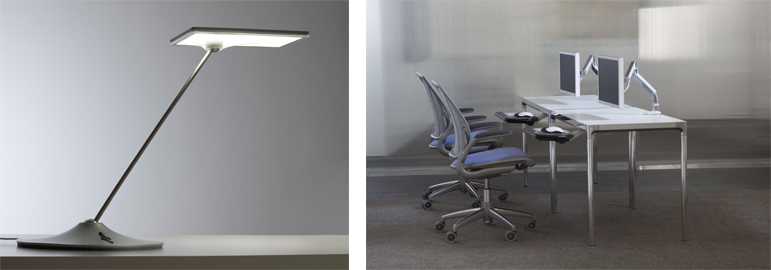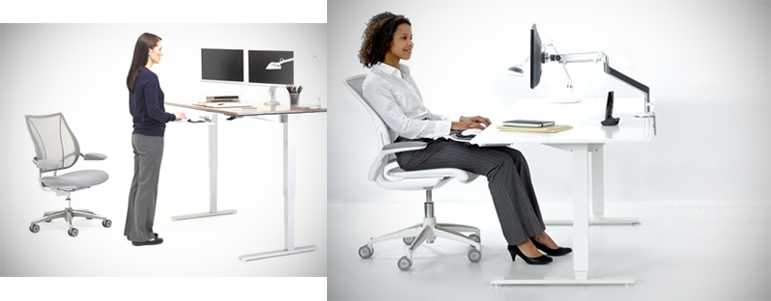What is the “Ergonomic Office”?
 For many years the term “ergonomic” has been used to add value to a product or to an environment (almost always work related). However can we be sure that this definition has always remained faithful to the principles of ergonomic methodology? The answer may be simple. I refer here to what I know best, and then only to the office environment, more specifically to video display terminal workstations. If the designer of these (especially new work spaces) considered the physiological and organizational wellbeing of the individual the core principle of the design process, the assumption would be completely valid and will hold until proven otherwise. It is therefore no coincidence that Ergonomics has always been defined as anthropocentric, as its correct application benefits the human being.
For many years the term “ergonomic” has been used to add value to a product or to an environment (almost always work related). However can we be sure that this definition has always remained faithful to the principles of ergonomic methodology? The answer may be simple. I refer here to what I know best, and then only to the office environment, more specifically to video display terminal workstations. If the designer of these (especially new work spaces) considered the physiological and organizational wellbeing of the individual the core principle of the design process, the assumption would be completely valid and will hold until proven otherwise. It is therefore no coincidence that Ergonomics has always been defined as anthropocentric, as its correct application benefits the human being. At this point, the reflection should be directed to minimum requirements (as cited in the Law: in progress, Community Directive 270/90 enacted in Legislative Decree 626/94 and included as part of T.U Legislative Decree 81/08 – Video display terminals, and in particular Annex XXXIV- paragraph 3 - title VII). To clarify my point of view: on the one hand the text of the Law introduces the obligation to “respect ergonomic principles in the design of workplaces, in selecting furnishings and in defining work and production methods, to mitigate monotonous and repetitive work”, but what actually occurs in reality?
This answer is even easier, especially from a historical, as well as technical point of view: in 1990 (with the introduction of Community Directive 270) almost none of the video displays were like those of today, which require the design of work spaces (desk dimensions, positioning of the video display, etc.) were completely different than those that are more recent, with a posture and organizational approach that is completely different. This mentality unfortunately has not kept up with either the technology or the postural position of the work station.
In fact it is constantly more difficult to evade the bad habits of yesterday, and today as in the past we still find the oldest and most widespread “negligent Disergonomics” in use in the work place: video display terminal operators almost always use the front part of the seat (forgetting that there is a backrest), resulting in an uncomfortable posture, and considerable fatigue to skeletal-muscular development as well as the vision, completely disregarding the Law and ergonomic methodologies. This translates into a loss in operating efficiency, in addition to which we can easily add the contribution to fatigue caused by low lighting where it is often most needed: on the keyboard and documents to be read.

Sometimes companies waste thousands of lux planted in the center of the ceiling, where it can easily be reduced to allow a noticeable savings in energy. The main remedy is better information/training on the part of those who are in charge: correct seating posture (no more stretching out towards the work surface from the edge of the seat) or assuming basically the same position as when you are driving, with the spine resting against the back of the seat. Focusing more on the physiological benefit/aspect (always health first!) is not complicated. Good will is obviously not enough: we also need work devices that motivate that change.
To get started just use the video display support on the work station, adjusting the height, depth and angle to assure a more elegant wiring and greater useable space on the desk itself. Correct posture in short can be translated into a suggestion that may appear “trivial”, yet effective: navel > plane and chin > center: adjust the height of the seat so that the navel is at the height of the flat work surface and the chin at the center of the video display. A video display that is fixed and that cannot be adjusted as noted above, adapting to the morphology of the individual obviously results in a progressively more uncomfortable use, as can be seen from the physiological perspective, and not comfortable adaptable to the individual according to his age, height, and visual acuity/ability.

Even a latest generation work lamp that gives a light very similar to natural light can be crucial in preventing eye fatigue, as well as assuring significant energy savings, including human energy. Two devices for work and not mere accessories (arm and light) assure immediate benefits, with a minimum investment. Just a few hundred euros can improve the quality of work life, and more. The Law on video display terminals as noted above, although frequently ignored, provides for the minimum that is essential, according to the individual. When interpreted in a more complete sense we find that it provides for “the use of a separate base for the screen” and continues with “general and specific lighting (work lamp) to guarantee sufficient lighting etc. Even more surprising is the general observations made in Section 34, which highlight “the use of the equipment should not be source of risk to the workers”.
But how many people are aware of their rights when working with video display terminals? The Law requires that they be informed and trained, so to speak, in workplace ergonomics; but is anyone really interested? Why don’t all employers, designers and experts in the workplace in general, especially those in the office sector, prefer to interpret the “risk assessment” in a way that is actually contrary, as if it were a risk to correctly assess the risk … perhaps because they think of costs and “there is no money”. Unfortunately too often we think it is more important to save on same items (video display arms and work lights without a doubt), rather than investing in the health and operating efficiency of the most value asset of any company: its human resources.
Luciano Guglielmini - country manager Humanscale – associate of SIE - Società Italiana di Ergonomia.

























































